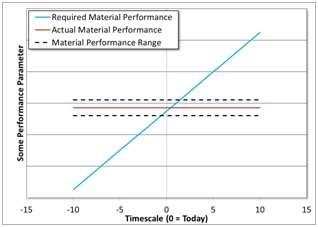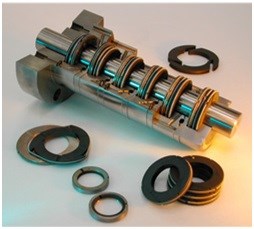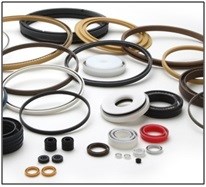High-Performance Polymers: The Gap Between Need and Science
In many engineering sectors, application environments for polymer-based materials are expanding into ever higher temperatures, differential pressures and increased corrosive chemical attack.
#materials
Supply and Demand are Out of Sync
Currently, the demand for appropriate materials to satisfy these ever increasing application targets has outpaced the speed at which material providers (i.e., companies that make the base polymers and those that modify or reinforce these same polymers) can provide material solutions with high confidence of success and supporting data to demonstrate that confidence. A key point here lies in the word confidence. As the market pull for new materials continues to accelerate, there is proportionately less fundamental and applied research occurring on newer, less prolific polymer types that truly considers the local environment that these materials encounter in their final, installed state.
Figure 1. Left: 2011 global annual market for HPPs in all industries. Market size: Sold resin in m/lbs and m/USD with 2007 material prices. Right: 2011 U.S. annual market for (currently at HCA processed) HPPs in the Oil and Gas industry. Market size: Sold resin in m/lbs and m/USD with 2011 material prices.
There are a number of reasons this mismatch in supply and demand exists, and why insufficient detailed application testing representative of these challenging environments is being done. In some cases it is more about economics than a lack of technical expertise or capability driving this trend.
Materials that far exceeded the demands of the application environments considered “the worst we will encounter” 25 years ago are today approaching, or in many cases not meeting the progressively increasing worst case scenarios.
Figure 2. The progressive creep of the increasingly more demanding application environments for high-performance polymers relative to the material performance that existed several years ago is depicted very simply above. The vertical axis is indicative of some key performance attribute of our polymer-based part, with the horizontal axis representing the passing of time measured in relative years. In many cases, the polyaryletherketone family of products, including the familiar PEEK polymer type was oversold into some applications. In effect, there was enough disparity between that material performance and the actual required performance that variability in the material properties or environmental variable still allowed the material to work successfully. The required material performance has been increasing steadily over the past few decades, and we are at a point today where developmental programs in the oil & gas sector have been stopped, due to the inability of what was previously a high-performing polymer component to keep up with the increasing demands of the applications in which they are used.
Economic Limitations
Materials that could be potentially useful in these demanding roles are, by volume, almost niche application areas compared to lower priced, intermediate performance polymers. The polymerizer has an obligation to be profitable, and across a polymer suppliers’ often broad portfolio of materials, they must support their higher volume, fully accepted and broadly applied polymers first to ensure longer term economic stability. If focus is switched to higher priced, lower volume materials, the assurance of volume growth in a given application space is not guaranteed. Putting effort and therefore money on the line to assist in the product development effort for these lower volumes is a business risk.
Similarly, conducting large numbers of application trials on higher performing materials in a wide range of potential but not certain conditions is a high risk and high cost endeavor that is likely to have a very long payback period, if at all. Thus, these higher performing materials are often taken to market and put into service without sufficient or appropriate amounts of technical data to assure that the polymer based component will meet the desired performance requirements. In effect, a portion of product testing and qualification is being done in the field rather than in the application test lab.
Polymer providers should not be faulted for not investing the huge amounts of time or money solving industry’s materials problems to satisfy every application problem that is truly niche. They are in the business of staying in business. So it is also industry’s responsibility to help the polymerizer be more responsive or willing to invest in these smaller volume opportunities. This would include providing substantially better feedback and material performance definition. Too often, a new or high-value polymer is taken into the company lab or field environment, the material fails, and the fault is laid at the feet of the polymer provider, with the only feedback given that “it didn’t work.”
In some cases there is not enough effort being made by the end user, in what is essentially a risk-sharing gesture, to provide accurate and detailed information about the component that failed. This information should include manufacturing conditions for the production of the part, the specific service environment it is placed in, and the events and data that describe the failure of the part.
Collaborative Product Development
We see more and more team-based collaborative product development initiatives being established where highly impacting problems exist, and this cross functional interaction between the team members with very different backgrounds is an effective means of tackling current problems. At a larger scale with longer timelines, we also see more industry/academic partnerships forming in North American universities in the form of research consortia, contract research agreements and the establishment of industry-sponsored research chairs or even entire specialized centers established within a faculty department in the institution.
For the material providers then, these structures and partnerships are a more cost-effective means to conduct basic and applied research. They can deliver significant value to the better understanding of the polymer materials performance expectations in the many different environments to which they are exposed.
Technical Challenges
One challenge of significant interest and concern is in testing standards development. Due to nothing more than history, the majority of current standard testing procedures for the evaluation of polymers and polymer-based materials subject the test specimens to moderate or room temperature test conditions, moderate rates of applied strain and moderate applied stresses.
Agencies like ASTM, ISO, NACE and others that assume responsibility for establishing appropriate testing standards need help. A simple example is in the testing temperatures specified for ASTM D638-03, which defines the procedures for testing of materials in tensile deformation. The temperature requirement is that the test be conducted at nominally room temperature. Certainly, it is not a big reach to understand the value of testing your material coupons at temperatures that are closer to the application temperature, but what temperature (or temperatures) do we choose?
A similar example may be drawn from tests for creep of polymer-based materials. A current standard (ASTM D2990-01) defines testing conditions at room temperature, which is effectively pointless when we are trying to assess the performance of a material in a ball valve seat in hot xylene service, or a valve sealing element in steam service. While we can adjust the test method, there should be agreement in the industry as to what modifications need to be made.
In some cases, no standard exists for some important tests in critical service components. For example, the evaluation of a thermoplastic anti-extrusion ring supporting an elastomer seal currently has no standard. At higher but not unusual operating pressures and temperatures (22,500 psi and up to 450°F, for example) it has a tendency to extrude into a wall gap with a dimension on the order of 3/1000 of an inch. The engineering service companies and end users revert to in-house contrived contraptions that they believe mimics the field experience of such parts and use this for qualification.
If there is no standardization of test method appropriate to the higher performing, higher strength materials of interest, then each agency will have its own in-house method for qualification and the burden is placed on the material providers to satisfy several different internal standards rather than to work towards a single, broadly used standard. The current approach adds cost and reluctance to participate in the provision of materials into this application space, as multiple solutions may have to be provided to the multiple companies that have their own unique qualification test.
Conclusion
For the industries that use higher performance polymers in more demanding application environments, testing and qualification standards need to be developed that are more closely matched to the service environment of the part. The present standards for testing of non-metallics are in many cases not reflective of the attributes that are of most concern when working at higher temperatures or pressures.
This gap represents heightened engineering risk, especially in the hands of a newly hired engineer who knows no better than to seek and use an existing standard or standards for the qualification of a new material, and rely on absolute values or comparative ranking to select the most appropriate material for the application as he/she understands it. This is not good practice. There are standards out there today from the ISO agency that make recommendations for thermoplastic materials used in oil and gas exploration and recovery environments that are incomplete as they only tell part of the story. In the hands of an inexperienced scientist or engineer, the potential is there to be harmful rather than helpful when qualifying or selecting appropriate materials for demanding service.
Overall, to improve our situation across the energy sector industries as a whole, we have opportunities and, to some degree, obligation as stewards of technology to make some changes. We can contribute by working towards or influencing improvements in existing or creation of new appropriate testing and qualification standards and devices that are reflective of the environments we encounter. We should strive to improve the quality of the feedback and interaction with polymer-material providers to establish cooperative working relationships and help them to understand how to better serve the application space that is critical to our success. Consider that the polymer producer is the most distant along the entire value chain from the end user of a finished part, yet they are the most critical element in that chain.
Finally, we must consider the relatively low cost but arguably high return on investment in establishing partnerships or participating in industrial academic forums and consortia to contribute to more focused and improved understanding of the gaps and risks that exist in our fundamental knowledge of the materials that are critical to future success in this industry.
Dr. Tim Bremner is the vice president of materials technology for Hoerbiger Corporation of America, Inc. Reach him at tim.bremner@hoerbiger.com.
RELATED CONTENT
-
Valves in Oxygen Service
In his presentation at VMA’s 2017 Technical Seminar, Kurt Larson, a process control engineer for Air Products, spoke about the inherent danger of the oxygen production business and how it is particularly important for end users and valve manufacturers to work closely together.
-
An Overview of ASME B16.34-2017
The content of American Society of Mechanical Engineers (ASME) Standard B16.34 is essential to those who deal with flanged, threaded and welded-end valves.
-
Understanding Torque for Quarter-Turn Valves
Valve manufacturers publish torques for their products so that actuation and mounting hardware can be properly selected.














 Unloading large gate valve.jpg;maxWidth=214)